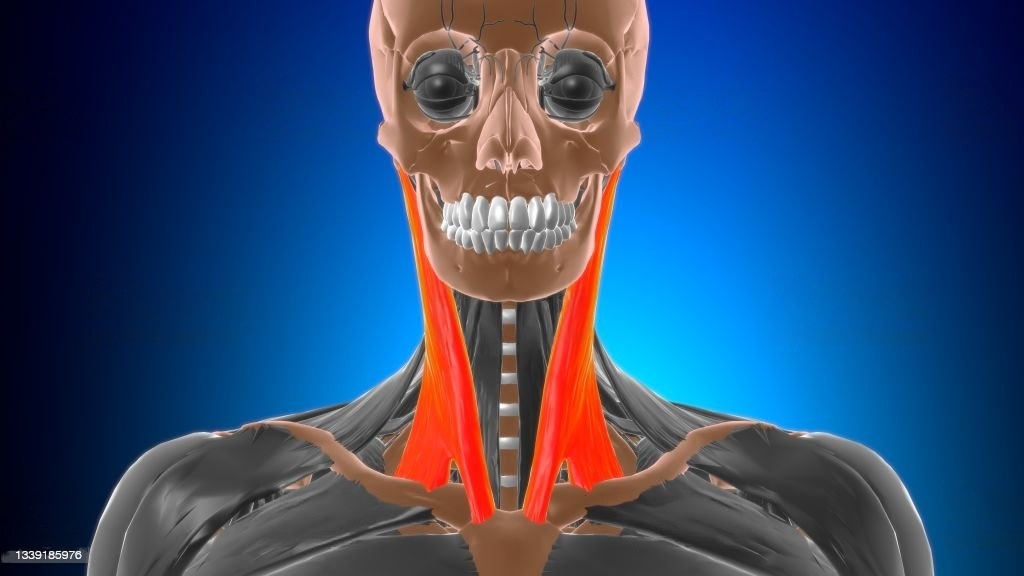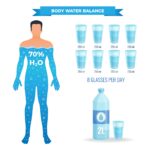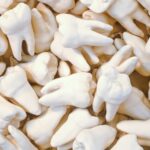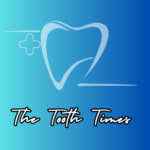The sternocleidomastoid muscle is a powerful and vital neck muscle that every dentist needs to be aware of. It is located in the anterior portion of the neck, running from the sternum to the mastoid process of the temporal bone, and is involved in several different dental procedures. It is important for dentists to understand the anatomy of this muscle in order to effectively diagnose and treat patients.
In this blog post, we will discuss the anatomy of the sternocleidomastoid muscle and its importance in dental procedures.

Anatomy of the Sternocleidomastoid Muscle
The sternocleidomastoid muscle, often referred to as the SCM, is a complex and important muscle located in the anterior portion of the neck. Its name comes from its attachment sites, with “sterno” referring to the sternum, “cleido” referring to the clavicle, and “mastoid” referring to the mastoid process of the temporal bone. This muscle has a unique and distinctive shape, resembling a thick band that runs diagonally from the sternum and clavicle to the mastoid process.
Anatomy-wise, the sternocleidomastoid muscle consists of two separate muscles on either side of the neck. It originates from the clavicle and sternum and inserts into the mastoid process. The two muscles, when working together, allow for the flexion of the neck, lateral flexion, and rotation. They also assist in the elevation of the sternum and clavicle during deep inhalation.
Blood Supply and Nerve supply
The blood supply to the sternocleidomastoid muscle comes from the superior thyroid artery and the occipital artery, while innervation is provided by the spinal accessory nerve (cranial nerve XI). This nerve is responsible for the motor function of the SCM muscle, controlling its movement.
Understanding the anatomy of the sternocleidomastoid muscle is crucial for dentists, as it plays a significant role in dental procedures. Its location and structure can impact the position of the head and neck during treatments, such as dental extractions, implant surgeries, and even routine cleanings. It is essential for dentists to consider the attachment points and function of this muscle when planning and performing procedures, as its involvement can affect patient comfort, stability, and overall treatment outcomes.
In the next sections, we will delve deeper into the functions, role, and effects of the sternocleidomastoid muscle in dentistry, as well as explore techniques to manage muscle tension for optimal patient care. Stay tuned for an informative journey into the world of the sternocleidomastoid muscle in dentistry.
Functions of the Sternocleidomastoid Muscle
The sternocleidomastoid muscle, or SCM, is a powerhouse when it comes to the functions it performs in the neck. This muscle plays a crucial role in a variety of movements and actions, making it an essential muscle for dentists to understand.
Neck flexion
One of the main functions of the sternocleidomastoid muscle is neck flexion. This means that it helps to bend the head forward and downward. Think about the movement you make when you lower your chin towards your chest – that’s neck flexion, and the sternocleidomastoid muscle is responsible for making it happen. This movement is often necessary during dental procedures, as it allows for better access and visibility within the oral cavity.
Lateral flexion of the neck
Another important function of the SCM is lateral flexion of the neck. This means it helps to tilt the head sideways, towards the shoulder. For example, when you tilt your head to the right to touch your ear to your shoulder, the sternocleidomastoid muscle is doing the work. This movement is useful in dental procedures that require access to the side of the mouth or when positioning the patient for optimal treatment.
Neck rotation
In addition to these movements, the sternocleidomastoid muscle also plays a role in neck rotation. This allows us to turn our heads from side to side. For dentists, this function is crucial when working on different sides of the mouth or when adjusting the patient’s head position for better treatment access.
Overall, the functions of the sternocleidomastoid muscle make it an integral part of dental procedures. Dentists rely on the movements facilitated by this muscle to ensure proper access, visibility, and patient comfort during treatments. Understanding how this muscle works and the role it plays in neck movement is essential for dentists to deliver effective dental care
Role of the Sternocleidomastoid Muscle in Dentistry

The sternocleidomastoid muscle, with its diverse range of functions, plays a significant role in the field of dentistry. As dental professionals, understanding the role of this muscle is crucial for providing effective and comfortable treatment to our patients.
Maintaining optimal head and neck position during dental procedures
One important role of the sternocleidomastoid muscle in dentistry is its involvement in maintaining optimal head and neck position during dental procedures. The muscle’s attachment points and structure impact the position of the head, allowing dentists to achieve better access and visibility within the oral cavity. Whether it’s a dental extraction, implant surgery, or a routine cleaning, the sternocleidomastoid muscle helps position the patient’s head for efficient treatment delivery.
Stabilizing the head
Moreover, the sternocleidomastoid muscle also assists in stabilizing the head during dental procedures. By working in conjunction with other muscles, it helps maintain a stable and steady position, reducing patient discomfort and increasing the dentist’s control during treatments. This stability is particularly important when performing intricate procedures that require precision and accuracy.
Furthermore, the sternocleidomastoid muscle can affect the overall treatment outcomes. Its involvement in neck movements allows for optimal treatment access, visibility, and comfort for the patient. Dentists who are aware of the muscle’s role can strategically plan their procedures, taking into consideration its impact on the head and neck position to ensure the best results.
In summary, the sternocleidomastoid muscle plays a vital role in dentistry. Its ability to position and stabilize the head, provide access and visibility, and improve overall treatment outcomes make it a muscle that every dentist needs to be familiar with. By understanding its role, dental professionals can optimize their treatment delivery and enhance patient comfort and satisfaction.
Effects of Dental Procedures on the Sternocleidomastoid Muscle
Dental procedures can have a significant impact on the sternocleidomastoid muscle. The positioning of the head and neck during treatments can put stress on this muscle, leading to potential effects and discomfort for patients.
Muscle tension or tightness
One of the most common effects of dental procedures on the sternocleidomastoid muscle is muscle tension or tightness. This can occur due to prolonged positioning of the head and neck during treatments, especially during lengthy procedures such as dental extractions or implant surgeries. When the head is tilted or turned for an extended period, the sternocleidomastoid muscle can become strained and develop tension. This tension can lead to pain, discomfort, and limited range of motion in the neck.
Muscle soreness and fatigue
In addition to muscle tension, dental procedures can also cause muscle soreness and fatigue in the sternocleidomastoid muscle. The repetitive movements and positions required during treatments can lead to muscle overuse, resulting in soreness and fatigue. This can be especially common in dentists who perform multiple procedures in a day or have long treatment sessions.
Temporomandibular joint (TMJ) disorders
Moreover, the sternocleidomastoid muscle can also be affected by temporomandibular joint (TMJ) disorders. TMJ disorders can cause pain and dysfunction in the jaw joint, which can radiate to the neck and affect the sternocleidomastoid muscle. Dental procedures that require extensive jaw movement or manipulation can aggravate these TMJ issues and further impact the sternocleidomastoid muscle.
To manage the effects of dental procedures on the sternocleidomastoid muscle, dentists can employ various strategies. Proper patient positioning and support during treatments can help minimize strain on the muscle. Taking breaks during lengthy procedures and incorporating stretches and exercises to relieve muscle tension can also be beneficial. Additionally, using ergonomic equipment and tools designed to reduce muscle strain can contribute to better patient comfort and less muscle-related complications.
Overall, understanding the effects of dental procedures on the sternocleidomastoid muscle is crucial for dentists to ensure optimal patient care and comfort. By being aware of the potential impact on this muscle and employing appropriate management techniques, dental professionals can minimize muscle tension, soreness, and other related issues, ultimately improving the overall treatment experience for their patients.
Techniques to Manage Sternocleidomastoid Muscle Tension in Dentistry

As dental professionals, it is essential to be aware of techniques to manage sternocleidomastoid muscle tension in order to provide optimal care and comfort to our patients. Here are some strategies and practices that can help alleviate muscle tension in the sternocleidomastoid muscle during dental procedures.
Proper patient positioning
Firstly, proper patient positioning is key to reducing strain on the muscle. Ensuring that the patient’s head and neck are properly supported and aligned can help minimize tension. Using pillows or neck supports can provide stability and reduce the risk of muscle strain.
Breaks during lengthy procedures
Additionally, incorporating breaks during lengthy procedures can give the sternocleidomastoid muscle some much-needed rest. Encouraging patients to take breaks to stretch and relax their neck muscles can help alleviate tension and improve patient comfort.
Stretching exercises
Incorporating stretching exercises into the treatment session can also be beneficial. Simple neck stretches, such as gently tilting the head from side to side or rotating it in a circular motion, can help relieve tension and increase blood flow to the muscle. These exercises can be performed before, during, and after the procedure to help manage muscle tension.
Heat or cold therapy
Another technique to manage sternocleidomastoid muscle tension is the use of heat or cold therapy. Applying a warm compress or using a heating pad on the neck area before or after the procedure can help relax the muscle and alleviate tension. Alternatively, using a cold pack or ice pack can help reduce inflammation and numb the area, providing temporary relief from muscle tension.
Using ergonomic equipment
Finally, using ergonomic equipment and tools designed to reduce muscle strain can significantly contribute to managing sternocleidomastoid muscle tension. Using dental chairs with adjustable headrests, ergonomic instruments, and proper lighting can help minimize strain on the muscle and improve overall patient comfort.
By implementing these techniques and practices, dentists can effectively manage sternocleidomastoid muscle tension during dental procedures, ultimately providing a more comfortable experience for their patients.
Applied aspects of sternocleidomastoid in dentistry

Now that we have explored the anatomy, functions, role, and effects of the sternocleidomastoid muscle in dentistry, let’s dive into the applied aspects of this muscle in the dental field.
One of the most crucial applications of the sternocleidomastoid muscle in dentistry is its role in patient positioning during dental procedures. The proper positioning of the head and neck is essential for optimal access and visibility within the oral cavity. By understanding the attachment points and functions of the sternocleidomastoid muscle, dentists can position the patient’s head in a way that allows for efficient treatment delivery. This positioning is especially important in procedures such as dental extractions, implant surgeries, and root canals, where precise access and visibility are crucial.
Furthermore, the sternocleidomastoid muscle also aids in stabilizing the head during dental procedures. By working in conjunction with other muscles, it helps maintain a stable and steady position, reducing patient discomfort and allowing dentists to perform intricate procedures with precision and accuracy. This stability is particularly important when performing procedures that require fine motor skills, such as placing dental implants or performing restorative work.
Additionally, the sternocleidomastoid muscle can have an impact on treatment outcomes. Its involvement in neck movements allows for optimal treatment access, visibility, and patient comfort. Dentists who are aware of the muscle’s role can strategically plan their procedures, taking into consideration its impact on the head and neck position to ensure the best results. By utilizing the sternocleidomastoid muscle to their advantage, dentists can enhance treatment outcomes and improve patient satisfaction.
conclision
the sternocleidomastoid muscle, with its intricate design and multifaceted functions, is a testament to the marvels of the human body. Understanding its anatomy, function, and importance can empower us to maintain proper posture, prevent discomfort, and even aid in early diagnosis of health issues. By caring for our sternocleidomastoid muscles through proper posture, regular movement, and relaxation techniques, we can ensure that these muscles continue to serve us well in our daily lives
For more about interesting trending blog do follow Trending Curiosity
For more update about Dental Health do visit The Tooth Times









very nice post helped me in my xam